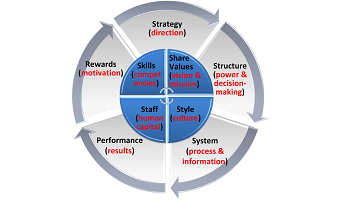- December 4, 2012
- Posted by: Javier González Montané
- Category: Turnaround

There are two frameworks focus on the theory that a company to perform properly need to be aligned in some important hard and soft elements.
The “Star Model” was created by Jay Galbraith in the 1960s. This framework remains important to create the foundation for companies design choices. Thus, this model identified five main design choices: strategy, structure, process, reward and people. The model is based on that design will affect employees’ behavior that will finally influence in the company culture and performance.
The “Mckinsey 7S Framework” was developed by Robert H. Waterman and Tom Perters in the 1970s. This quite similar and still actual framework has 3 hard elements (strategy, structure, and systems) and 4 soft elements (shared values, skills, style, and staff).
The utility of “Star Model” and “7S Framework” for turnaround
- Those frameworks help us not to forget any important element in the firm.
- In restructuring any time we are conscientious affecting some of those elements, and the model is going to remember us that any change in one of the elements must be aligned with the rest of the elements.
- Turnaround process use change management initiatives continuously and these models consider soft factor too.
So our recommendation is using the best of both models, we mean using all the factors suggested for both models. So “Star Model” compared with the “7S Framework” incorporates the reward factor and performance. On the other hand, “7S Framework” incorporates shared values, separate people in two factors (staff and skills), and shows systems (culture) like a new factor rather than a consequence of the factors.
The turnaround framework
Adapted from "Star Model" (Jay Galbraith) and "7S Framework" (Robert H. Waterman and Tom Perters)
- Strategy: What is the formula for success? How do we differentiate ourselves from our competitors? What are the organizational drivers?
- Structure: How are we organized? What are the key roles? How is the work managed? Who has power and authority?
- System/Processes: How are decisions made? How does work flow between roles? What are the mechanisms for collaboration?
- Performance: How are we doing? Why?
- Rewards: How is behavior shaped by the goals? How do we assess progress?
- Share values: What types of issues do the receive the least and most of the management attention?
- Style/Culture: How does top management make decisions? How do managers spend their time?
- Staff: How do we recruit and develop our talent?
- Skills: What is the company or team known for doing well?

